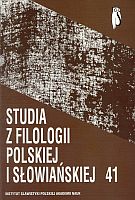Stałość versus zmienność dialektów cieszyńskich
Dialects of the Cieszyn Region: Immutability versus Change
Author(s): Zbigniew GreńSubject(s): Language and Literature Studies
Published by: Instytut Slawistyki Polskiej Akademii Nauk
Summary/Abstract: The Author had set himself a goal of finding the reply to a question that expresses interest in the dynamics of the current developments in the Cieszyn-region dialects and, what is connected to that issue, the dialect(s)’ stability. That stability and consistency happens to be overridden by the neighbouring influence of other codes (the literary languages and dialects) and by the interrelation between lexical and socio ethnic melting (ethnic and regional groups) in the region. The issue is that those processes may lead to disintegration of the traditional Cieszyn and regional communities’ communication codes or at least enforce their evolution (be it faster or slower). The analysis of the material gathered from the research questionnaires suggests that in the Cieszyn area the language communication develops and changes, and that seems to be the effect of coexistence of a number of communication groups and of the multitude of the communicational situations that are not heterogeneous linguistically. Further changes may be attributed to variegation of codes reflecting the complex situation of communication groups. Within the Cieszyn Community there are groups with a permanent and stable code that perform the primary functions – the original, native folk, but also involving aliens and the groups of two- and more-codes coexisting within a group though their degree of anchoring within the code is variegated: dialect – general language (in its primary / secondary function). There are interferences and exchanges between those communication groups, and the character of those exchanges is permanent. Their visibility is particularly strong in the intermediate groups – in the mixed ones, where – within one family - two codes appear: one is the dialect and the other the literary language; or perhaps two dialects may exist within that family; when one considers the complete local environment, friends, what is important for the youth, as many as three dialects may be present. And that is the middle, mixed groups which create interferences within one family, in which, on the one hand, mixed texts are created, albeit in the individual and not yet group dimension – on the other hand, clearly, the language consciousness is already shaken, and not only the character of texts but the characters of the codes are not recognized any longer (for instance the dialect is wrongly considered to be a slang by people in whom their dialect is existent in its secondary function). In such people the natural consequence is the disintegration of their dialect and a transition of its role to its code of the secondary function.
Journal: Studia z Filologii Polskiej i Słowiańskiej
- Issue Year: 2006
- Issue No: 41
- Page Range: 45-58
- Page Count: 14
- Language: Polish

